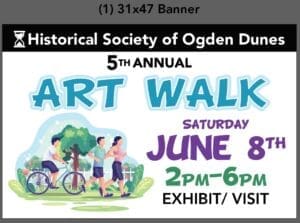Ogden Dunes and the Planned City of Port Williams
By Dick Meister
In the 2010 donation to the Historical Society of the papers of the late Joseph Thomas, an Ogden Dunes resident, journalist and editor for the Gary Post-Tribune, by his daughter (see September 2010 issue of The Hour Glass Newsletter) was a large plat map of the proposed city of Port Williams to be located just east of Burns Ditch and south of Dunes Highway (U.S. 12). Port Williams was to be another Gary and is a precursor of Burns Harbor and the Port of Indiana.
The vision for this proposed city grew out of the economic optimism that preceded the collapsed of the stock market in October 1929. However, by January 1930 the market appeared to be recovering and in the Midwest steel production was increasing. In Gary mill production was at 90% at the end of January. (Gary Post-Tribune, 1/31/30) As a result the steel industry revived plans to expand in Northwest, Indiana, intending to hire 1,500 construction workers. (PT, 1/24/30)
The Gary Post-Tribune on January 8, 1930 also reported that Weirton Steel had purchased 60 acres of land around Burns Ditch and was negotiating with Consumers Company for 2,000 acres east of the dunes. A day later National Steel, a result of the 1929 merger of Weirton Steel and Great Lakes Steel, had purchased 720 acres from Consumers Corporation for $1 million. It planned to spend $50 million on a new steel mill, a harbor, and a new city. Samuel Insull, who owned the South Shore and utility companies, was also involved in this planning. The planned harbor was to be built on the eastern edge of the property, not at Burns Ditch.
Six months later Ernest Weir, chairman of National Steel, announced the formation of asubsidiary, Midwest Steel, which was incorporated in Indiana. The first phase was to be completed in 18 months with the larger project in three years. (6/2//30; 6/30/30) Two months later the Gary Post reported on negotiations to move the Indiana Harbor Belt line railroad tracks in order to build the steel mill. (8/19/30)
By 1931 the economy of the United States was again collapsing. Yet, articles still appeared about the proposed mill and city. On April 15, Midwest Steel announced it had finalized the deed for the property at the mouth of Burns Ditch and that construction was to begin in 1932. That December plans for development of northwest Indiana were expanded. Governor Leslie proposed to link the Great Lakes with the Atlantic Ocean, allowing East Chicago, Gary, and the proposed Port Williams at Ogden dunes a great shipping center. (12/3/1931)
The next four years were tragic ones for the United States. Bly 1935 the economy showed some signs of reviving and the New Deal was investing in large public works projects. One of these projects was the development of a port in northern Indiana. National (Midwest) Steel committed itself to build the steel mill if the port was approved and the $3 million cost was funded by the federal government. In August 1935 the Army Corps of Engineers held public hearings about the proposed port. Governor Port McNutt and Congressman Manion of Gary attended the hearing. (7/19/1935; 8/16/1935)
In May of 1936, despite the hearings and the support for economic development of northwest Indiana, the Army Corps of Engineers rejected the proposal for a port, arguing that the economic benefits did not justify spending $3 million. It was the 3rd time that the Army had rejected the proposal. National Steel also announced that it was rescinding its proposal build a $5 million tin mill by Burns Ditch. It had hoped that by doing so, it would allow the port to move forward Up to that time the major argument against the project was that it was using tax dollars to benefit a single private corporation. (4/4/1936; 5/2/1936)
Yet, the plans would not die. National Steel announced it was going to move ahead on a $7 million tin refinishing mill on Burns Ditch and this would be followed by other projects. And the Army Corps again agreed to hold hearings on the port. By the end of 1937 the northwestern Indiana mayors and representatives of the steel corporations were divided about the port near Burns Ditch. Hammond and East Chicago came out against the port and proposed improving the Grand Calumet so that barges could go through to the Mississippi river. They argued that the port was a private one for Weir and real estate developers. The Gary Post-Tribune editorial on December 30 denounced the parochialism of Hammond. (11/10/1937; 12/29/1937; 12/30/1937)
Eighteen months later, the Gary Post called upon Garyites to wake up and organize. This was in response to the $26 million Calumet Waterway Development plan that was in the process of being approved. This plan called for extending the Grand Calumet to the Calumet Sag Canal at Blue Island; thus to the Mississippi. The editorial “Gary Needs a Harbor” argued that since 1910 63 new industries had been established in Hammond, Whiting and East Chicago that employed 23,000 workers. But no new industries had located in Gary because of the lack of access to Lake Michigan. (5/27/1939; 6/24/1939)
While this was going on, the residents and 2nd home owners in Ogden Dunes prayed that a twin city would not materialize to the east and that their beloved dunes would remain. The fears of a port and mills to the east were again reawakened in the 1950s. This time, economic interests overwhelmed the proponents of dunes.


